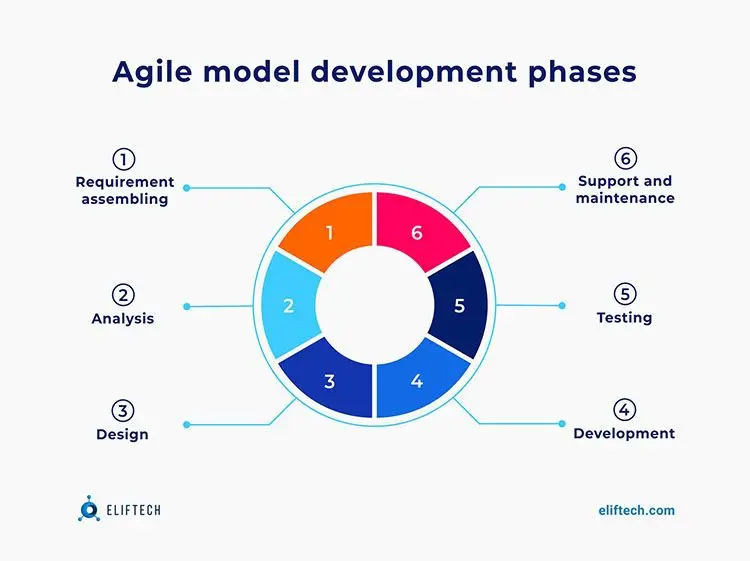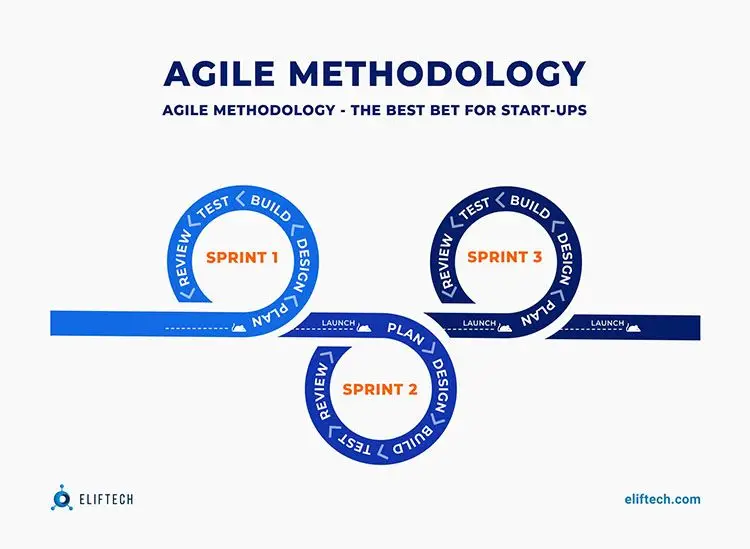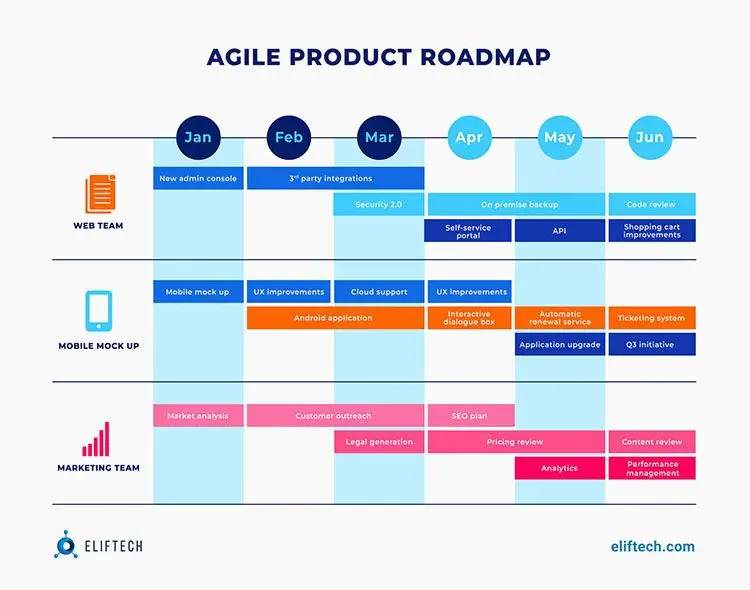Startup
The Complete Guide to Agile Software Development Life Cycle for Startups

Have you ever experienced a case where the project is all set and almost done, and the idea to add a new feature appears? Sure, it is possible, but what is the cost of implementing such a change? It means potentially overrunning the original budget, assigning more tasks to the team, and planning the workload from scratch.
It can be done differently, though. When you apply Agile principles to your processes, diving into changes won't look like a bottomless money pit. You can always apply Agile software development life cycle principles to be in control even in the most turbulent times, whether in the early stage startup, meaning testing and gaining traction with your ideas, or growth stage startup, where expansion brings new challenges.
What is Agile Software Development Life Cycle?
The Agile software development life cycle for startups is a framework of project management created to produce software products in a flexible and incremental manner. Agile focuses on the collaboration of tech and non-tech specialists and continuous product improvement that allows easy adaptation to changing markets and requirements.
Traditionally, the Agile software development life cycle for startups has the following stages:
- Planning. At this stage, the team meets the client to identify the requirements. They divide the project into sprints and focus on the priority tasks. Special attention is paid to sprint goals and outcomes, and a lot of communication with the client happens since feedback is crucial.
- Design. During this stage, the team works on designing the software architecture and user stories. By breaking down the workload into smaller user stories, the team can quickly deliver value to the client and receive feedback immediately.
- Development. A common practice is to code and test the software in two-weeks sprints. However, it depends on the pace selected by the client and developers. After each sprint, the client receives an increment and can suggest changes if desired.
- Testing. Regular checks of the software with the help of comprehensive testing help the team ensure that they are on the right track and the product meets the client's requirements. Each sprint completes the product, and the first usable version might be produced in only a couple of weeks.
- Deployment. This stage envisages deployment to a production environment. The product is finalized and refined for the end users.

Why Agile Software Development Life Cycle for Startups?
Startups operate in a dynamic environment where maintaining a competitive edge throughout the lifecycle of a startup business is key. Considering often limited budgets, delivering new, disruptive products and services to the market ahead of the competitors becomes a challenge. Hence, Agile is the go-to method for startups.
The benefits of an Agile software development life cycle for startups include:
- Quick adaptation. As the environment changes, startups have to keep up and introduce the needed modification instantly without long-winded bureaucratic procedures. Sometimes, a pivot is required to respond, and Agile is all about being open-ended.
- Fast time-to-market. It's vital for a startup to get a foothold in a new market, and Agile helps with that. Each sprint prioritizes the delivery of the working product and increases the overall time-to-market.
- Collaboration. In addition to a limited budget, startups often have small teams and constrained resources. Agile envisages cooperation and active participation of stakeholders, developers, and other team members, which benefits a startup.
- Continuous improvement. Feedback loops and retrospective helps startup teams effectively learn from their experiences and establish the right working process over time. Besides, Agile works by iterations meaning the product can be improved instantly, preventing unnecessary expenses.
- Risk mitigation. Following incremental product delivery reduces risks. The team is able to test and validate ideas in the early stages. In this way, startups avoid investing too many resources into a product that won't meet the market requirements.
- Segmentation into small tasks. Let's say a team is developing a smart home project. Multiple risks are associated with such a large workload. Hence, Agile helps to break it down into manageable pieces. After each sprint, the team can assess the budget, plan their next steps and focus on what's important to deliver the product to the end user instead of adding optional features.

Planning Your Project with Agile
Organizations that apply the Agile software development life cycle have both chaos and order simultaneously. Less emphasis is put on documentation like contracts and agreements and more on collaboration and people interactions. Personal meetings with all the stakeholders and constant updates on the sprint goals drive the success of the agile-operated team. The advantage of this method is adaptability.
So, if you want to incorporate some bits of Agile software development and some you find not suitable for your organization, you can easily bend the rules. Yet, here are some things to consider if you want to be productive:
- Collaboration and self-organizing teams. Although team members traditionally have roles (product owner, project manager, etc.), spontaneous ideas and improvisation moves the process and creates innovation.
- Iterative development. Agile software development happens in iterations, and each has to bring value, so the work is not done for the sake of completing vague tasks.
- Product backlog review. It is an evolving element, and reviewing it after every iteration is recommended to ensure all the changes are considered.
Agile Roadmap
The Agile software development roadmap displays visually a product development plan. It serves as an aid for the teams to prioritize and manage their workload. In other words, it shows the way for all the involved parties.
The building blocks of the Agile roadmap are:
- Product vision. It usually comes as a statement that provides the purpose of the product and its goals.
- Themes present the functionality. They include user experience, security, and performance. For example, when developing a solution for tech company processes, we indicated the following broad areas of functionality: work planning, resource management, time tracking, automatic invoices, and online reports.
- Epics break down the larger functionality areas into smaller bits. For example, work planning is divided into client and project management, tracking, etc.
- User stories also describe features of the product but from a different perspective. To be specific, they are written from the user's point of view. For example, "As a senior manager, I want to assign tasks to my team to ensure tracking of the completion progress."
- Sprint goals. For the team to not get overwhelmed with the tasks, prioritization happens with the help of sprints. These are usually 2-4 weeks, within which some valuable outcomes are expected. Each outcome is aligned with the product vision and client expectations. Hence the team always stays on the right track.
- Milestones are the dates and events the team aims to reach in the development process. These can be product launches, features release, or some major tests.
Since Agile software development is flexible and adaptable, the roadmap is dynamic as well. It is updated on the go, changed, and constantly evolves. It is also up to teams to structure it and use all the convenient tools that facilitate communication and collaboration between all stakeholders, clients, and teams.

Agile Project Management Tools & Techniques
Agile project management tools and techniques are designed to help teams plan, execute and track their progress and remain flexible and iterative. The teams are free to select the needed tools for the project, depending on the scale, resources, human resources, and goals.
Among the widely used and recognized techniques and tools are:
- Sprint planning — used to decide on the priority user stories and the amount of workload that can be handled during the sprint. In the process, the number of stories may grow or decrease, and the priorities may change. It allows the teams to react quickly and not waste time on bureaucracy.
- Sprint review — after completing a sprint, the team presents the outcomes or increments to the client and receives feedback. Based on the received review, they plan the next sprint.
- Sprint retrospective — designed to conduct an after-action review and analyze what went well or wrong. The learning points are then implemented into the following planning stages.
- Product backlog — represented by a list of user stories prioritized according to their importance. It is dynamic, and the focus may change, and the priorities will change as well. So, the product backlog keeps getting updated and refined.
- Daily stand-ups — short meetings during which the team can discuss roadblocks, progress, and plans for the day. They aim to align everyone and ensure the team is moving in the same direction.
- Kanban boards — work as visualization boards for user stories and sprints. They are used to ensure that every team member knows the current goals and completes priority tasks.
- Burndown charts — used for tracking the sprint's progress and visualizing the issues that need to be addressed.
All the tools used in the Agile software development life cycle are focused on keeping all parties focused on the goal and delivering the product to market as soon as possible without sacrificing the quality. They also facilitate the work of remote teams and promote active interaction between all the stakeholders involved in the project.
How Do Agile Methodologies Fit in the Remote Work Era?
Agile software development methodologies fit perfectly into the remote work era, and even more, they answer many questions companies face when employing distributed teams.
Undoubtedly, employees show high confidence in their decisions to work from home, and their benefits are undeniable. Yet, companies struggle to arrange the workflow everyone is used to. The studies show remote workers feel disconnected from their teams and often experience miscommunication.
How does Agile help? With the way Agile software development planning is conducted, every team member has a mission, clear priorities, and the order of task execution. Daily strand-ups and progress dashboards align the goals and help the teams synchronize.
COVID-19 tested Agile practices to the full extent. As a result, the post-epidemic business environment concluded that this methodology helped teams outperform in such a turbulent time and opened new opportunities for remote workers. As a result, Agile team leaders managed to navigate a challenging pandemic landscape while staying focused on the main goal - delivering value to the client.
Delivering a Successful Product with the Agile Model
While the Agile model is flexible and adaptable, it still requires a degree of discipline. The individuals running the process should always remain focused on achieving results. Setting correct priorities and goals and shifting the project's direction when necessary is vital. In short, it is essential to keep a sense of structure. It's possible to do that when the client's vision is clearly stated, and the team follows some algorithm.
Let's look at the basic steps that ensure that the team delivers a successful product with the Agile model:
- Get a definition of your product vision.
- Design your product vision.
- Plan sprints.
- Execute sprints.
- Take sprint reviews and retrospectives.
- Refine the product continuously.
With practice, tech teams get more and more insights into which tools serve them best and what Agile techniques are suitable for different projects.
At Eliftech, we have expertise in applying the Agile approach and delivering products for Healthcare, e-Commerce, FinTech, and more. So, if you are overwhelmed with ideas and want to fit your dream product into the budget, we look forward to meeting you.
Final Thoughts
Agile is a methodology oriented at delivering results quickly. Regardless of the stages of startup development, it is a suitable way to build your product development process. Whether you have a team of two or two hundred, Agile software development has all means to arrange the work to satisfy all the stakeholders, developers, and clients. It is a way to achieve your goals and improve the work culture and efficiency. Get in touch with Eliftech experts for more details.
